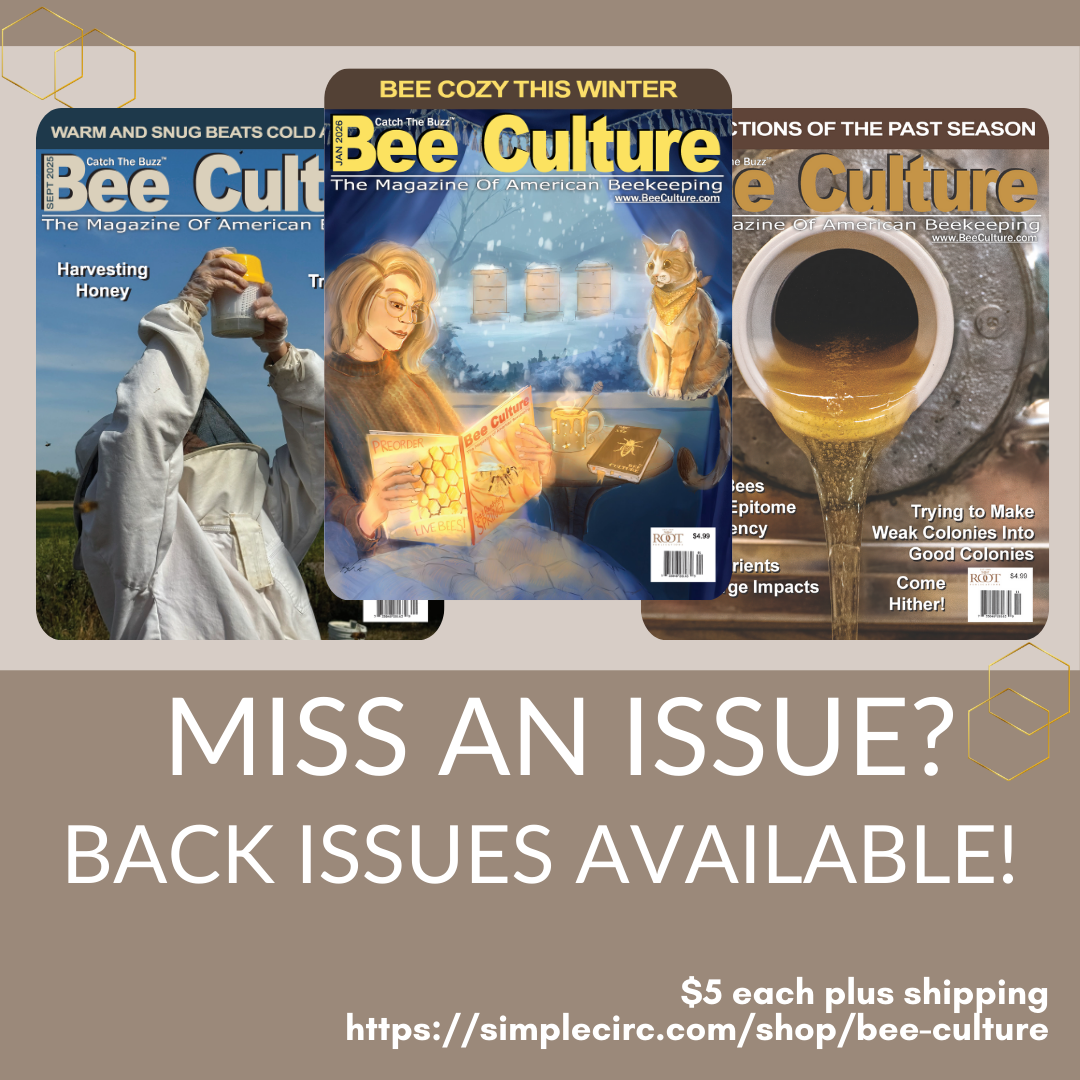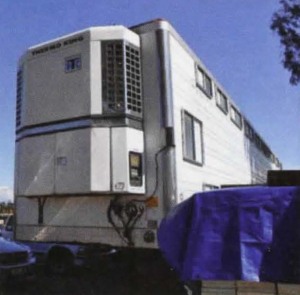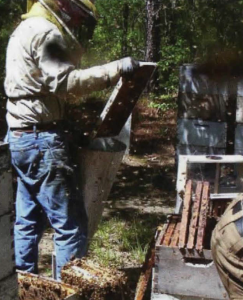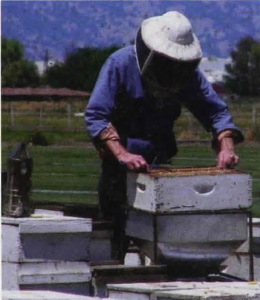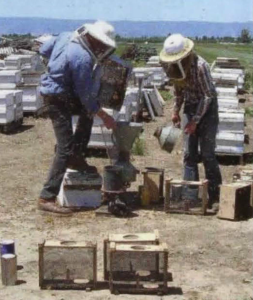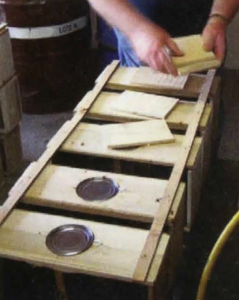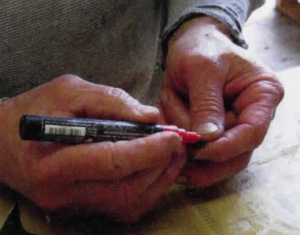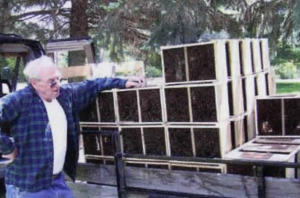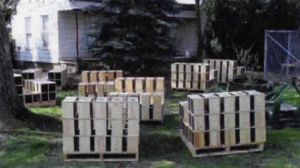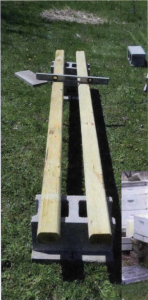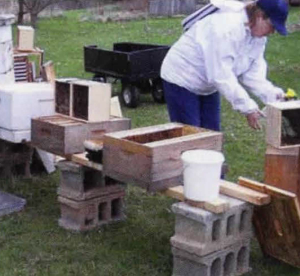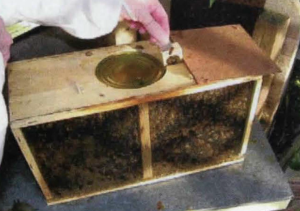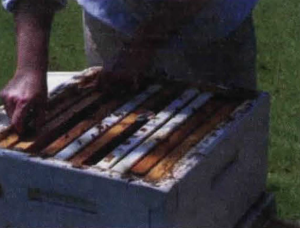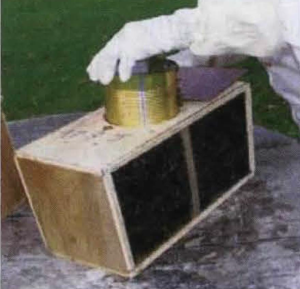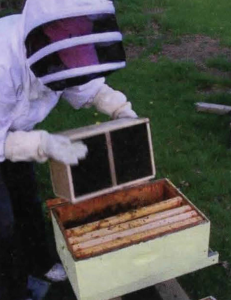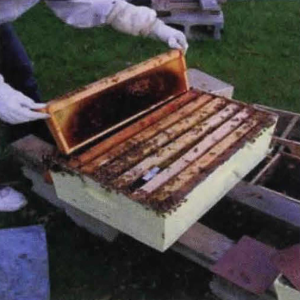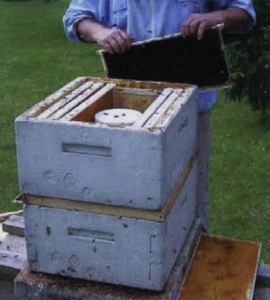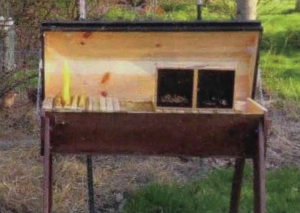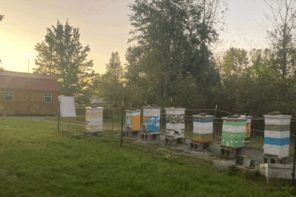By: Kim Flottum
This article originally appeared in the Spring 2020 issue of BEEKeeping Your First Three Years
Bees are collected, either by shaking frames in to a funnel that fills the package, or by bouncing a hole super over a collection box. A queen excluder on top keeps the queen in the super. Then bees in the box are then poured into a package. Packages removed from the field and assembled in the warehouse, where a feeder can and a queen are added, and the opening covered to keep them all in. Packages are shipped in specialized trailers with climate control.
Packages of honey bees come from, basically, two areas of the U.S., the southeast, mainly southern Georgia and northern Florida, and from the west, mainly central and northern California. There are differences in the queens you get from these places because of where they are raised and how they are produced. To make a package in the SE, producers search for the queen in the production colonies and once found, isolate her, then shake about a third of the worker bees in that colony into a collection container to be doled out and weighed and put into a 3 pound package. West coast package producers simply sift a super or two of bees from a colony into a container that has a queen excluder on top, so only workers go into the collection container. Workers are poured into the package, a can of sugar syrup is added along with a queen raised specifically for this purpose and the entrance sealed. The package is then shipped in special trailers, with air conditioning and humidity controls to a local supplier who then distributes them to you.
Getting ready. Make sure your hive stand is strong, gather all your tools and be ready. Have feeder pails and mister filled with 1: 1 sugar syrup.
Pick up the bees. Most of us have a car. Put cardboard or several layers of newspaper on the backseat to place the package on. When you arrive expect a crowd of anxious beekeepers – just like you. Make sure you get the kind of bees you ordered – Italian, Carniolan, Russian, Buckfast – and that the queen is marked. Your queen may arrive marked, or she may get marked there. The bees should be hanging around the queen and feeder can, and there should be only a very few dead bees on the bottom of the cage. If more than 20 the package may be old bees, starving, overheated or subjected to something not to their liking. Check with the supplier if there are lots of dead bees. Bring a mister with sugar syrup in it and before you put the package in the car, feed the bees. This will settle them down a bit and give them something to do while on the trip home. This is why you need the newspaper. Don’t let the car overheat. Tend toward air conditioning to keep the bees cool.
When ready, assemble everything in the bee yard. To begin, thump the package to settle the bees on the bottom. Remove the cover and the queen and keep her warm. Remove 4 or 5 frames from you super. Thump gain, remove can and cover and dump the bees in the super. Replace the frames, put the pail over the inner over hole, put a super on to protect the feeder, close and done. If installing in a top bar hive, put a feeder (here a Boardman feeder works well) in one end without bars, put bars in about 2/3 of the hive, dump the bees where the opening is, replace bars and close.
Your supplier will tell you when the packages are to arrive so you can be prepared the day they come in. Have your hive stand ready, make sure you have plenty of sugar syrup ready for feeding and your boxes, frames, bottoms and covers are ready. If new, paint the boxes. The day the packages arrive, before you go to pick them up, get all your equipment out to the bee yard. Smoker and fuel, the box and frames the bees will go in along with the bottom board, inner cover and cover, hive tools, spray mister full of 1:1 sugar syrup, extra boxes to house the feeders on top of the box you will put the bees in, rubber bands to hold the queen cage on a frame if there’s no way to hang it from the top bar, a fl.at head screwdriver for removing the feeder can if it’s stuck in the opening of the package. If the weather doesn’t cooperate when you get back home, put your package in a cool, dark place until you can get it introduced. A garage or basement is common. Feed, feed, feed the bees. Assume the feeder can is empty and they have no food. Generously spray both sides of the package with your mister 3 or 4 times a day to the point the bees are wet. This many bees will easily consume a quart of syrup in 24 hours, so don’t get cheap now. They will starve if indeed the can is empty and you don’t feed. Introduce as soon as possible when the weather clears.
When the time is right, install your package. Ideally, this is toward evening on a warm, friendly day, but we don’t always have that luxury. Sooner rather than later, within reason is the rule. Make sure all your equipment is in the bee yard. Put on your bee suit. You probably won’t need your smoker, but light it anyway, just for the practice and have it ready. Make sure your feeder pail and your mister are full of 1:1 sugar syrup. Inspect the package again to make sure the bees are doing well. Mist them to settle them down. Place the package on a firm surface and remove the cover over the feeder can if there is one.
If the queen cage is right there, remove it, blow off any clinging bees and put her in your pocket for protection. If she’s inside the cage, carefully thump the cage to knock the bees off the can and onto the floor. Pry the feeder can out, remove the queen and replace the cover. Remove 3 or 4 frames from your prepared box and hang the queen cage, using the metal hook or hanger attached to the cage. If there isn’t one, or it doesn’t work, use the rubber band to hold the cage near the top and end of the frame. Don’t put her in the middle because if the feed can leaks she will drown. Have the inner cover handy. Mist the bees. Knock them down again, give them a minute to settle a bit, then remove the feeder can completely. Cover the opening, take a breath, and begin slowly dumping the bees into the opening in the box. Shake it a little, tip it back and forth a few times and get most of them out. Then put the package in front of the hive and let the remaining bees find home. Carefully replace the frames, letting their own weight push the bees out of the way. When done, put on the inner cover, the feed pail over the hole, the extra box to protect the pail, and finally the cover. It’s done. Give them a day or so to settle in, make sure the feed pail stays full and that the queen gets released in a week or so. You’re a beekeeper!






